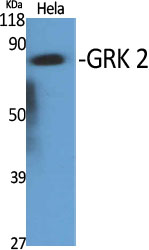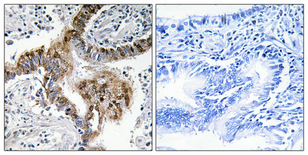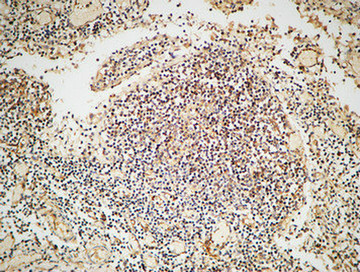GRK 2 Polyclonal Antibody
- Catalog No.:YT2064
- Applications:WB;IHC;IF;ELISA
- Reactivity:Human;Mouse;Rat
- Target:
- GRK 2
- Fields:
- >>Chemokine signaling pathway;>>Endocytosis;>>Hedgehog signaling pathway;>>Glutamatergic synapse;>>Olfactory transduction;>>Morphine addiction
- Gene Name:
- ADRBK1
- Protein Name:
- Beta-adrenergic receptor kinase 1
- Human Gene Id:
- 156
- Human Swiss Prot No:
- P25098
- Mouse Swiss Prot No:
- Q99MK8
- Rat Gene Id:
- 25238
- Rat Swiss Prot No:
- P26817
- Immunogen:
- The antiserum was produced against synthesized peptide derived from human ARBK1. AA range:601-650
- Specificity:
- GRK 2 Polyclonal Antibody detects endogenous levels of GRK 2 protein.
- Formulation:
- Liquid in PBS containing 50% glycerol, 0.5% BSA and 0.02% sodium azide.
- Source:
- Polyclonal, Rabbit,IgG
- Dilution:
- WB 1:500 - 1:2000. IHC 1:100 - 1:300. ELISA: 1:20000.. IF 1:50-200
- Purification:
- The antibody was affinity-purified from rabbit antiserum by affinity-chromatography using epitope-specific immunogen.
- Concentration:
- 1 mg/ml
- Storage Stability:
- -15°C to -25°C/1 year(Do not lower than -25°C)
- Other Name:
- ADRBK1;BARK;BARK1;GRK2;Beta-adrenergic receptor kinase 1;Beta-ARK-1;G-protein coupled receptor kinase 2
- Observed Band(KD):
- 80kD
- Background:
- The product of this gene phosphorylates the beta-2-adrenergic receptor and appears to mediate agonist-specific desensitization observed at high agonist concentrations. This protein is an ubiquitous cytosolic enzyme that specifically phosphorylates the activated form of the beta-adrenergic and related G-protein-coupled receptors. Abnormal coupling of beta-adrenergic receptor to G protein is involved in the pathogenesis of the failing heart. [provided by RefSeq, Jul 2008],
- Function:
- catalytic activity:ATP + [beta-adrenergic receptor] = ADP + [beta-adrenergic receptor] phosphate.,catalytic activity:ATP + a protein = ADP + a phosphoprotein.,function:Specifically phosphorylates the agonist-occupied form of the beta-adrenergic and closely related receptors, probably inducing a desensitization of them.,online information:Beta adrenergic receptor kinase entry,similarity:Belongs to the protein kinase superfamily. AGC Ser/Thr protein kinase family. GPRK subfamily.,similarity:Contains 1 AGC-kinase C-terminal domain.,similarity:Contains 1 PH domain.,similarity:Contains 1 protein kinase domain.,similarity:Contains 1 RGS domain.,subunit:Interacts with GIT1 (By similarity). Interacts with, and phosphorylates chemokine-stimulated CCR5.,tissue specificity:Expressed in peripheral blood leukocytes.,
- Subcellular Location:
- Cytoplasm . Cell membrane . Cell junction, synapse, postsynapse . Cell junction, synapse, presynapse .
- Expression:
- Expressed in peripheral blood leukocytes.
- June 19-2018
- WESTERN IMMUNOBLOTTING PROTOCOL
- June 19-2018
- IMMUNOHISTOCHEMISTRY-PARAFFIN PROTOCOL
- June 19-2018
- IMMUNOFLUORESCENCE PROTOCOL
- September 08-2020
- FLOW-CYTOMEYRT-PROTOCOL
- May 20-2022
- Cell-Based ELISA│解您多样本WB检测之困扰
- July 13-2018
- CELL-BASED-ELISA-PROTOCOL-FOR-ACETYL-PROTEIN
- July 13-2018
- CELL-BASED-ELISA-PROTOCOL-FOR-PHOSPHO-PROTEIN
- July 13-2018
- Antibody-FAQs
- Products Images

- Western Blot analysis of various cells using GRK 2 Polyclonal Antibody
.jpg)
- Western Blot analysis of HuvEc cells using GRK 2 Polyclonal Antibody

- Immunohistochemical analysis of paraffin-embedded Human lung cancer. Antibody was diluted at 1:100(4° overnight). High-pressure and temperature Tris-EDTA,pH8.0 was used for antigen retrieval. Negetive contrl (right) obtaned from antibody was pre-absorbed by immunogen peptide.

- Immunohistochemical analysis of paraffin-embedded Human Lymph gland. 1, Antibody was diluted at 1:100(4° overnight). 2, High-pressure and temperature EDTA, pH8.0 was used for antigen retrieval. 3,Secondary antibody was diluted at 1:200(room temperature, 30min).

- Western blot analysis of lysates from HUVEC cells, using ARBK1 Antibody. The lane on the right is blocked with the synthesized peptide.



